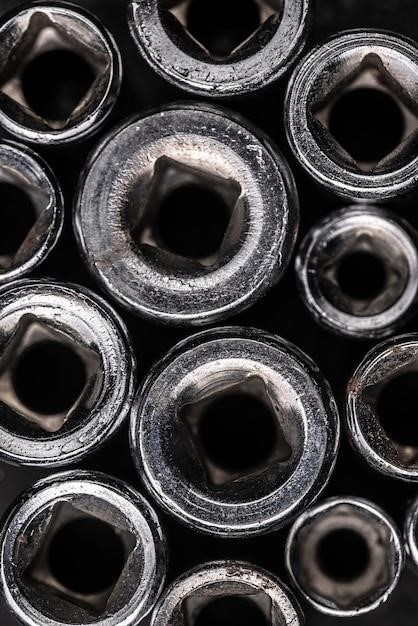Knurling Valve Guides⁚ A Comprehensive Guide
Knurling valve guides is a common repair method for worn-out valve guides in internal combustion engines․ This process involves creating a spiral groove on the inner surface of the valve guide to reduce the clearance between the valve stem and the guide, thereby controlling oil loss and ensuring proper valve alignment․ This comprehensive guide will explore the various aspects of knurling valve guides, including its purpose, benefits, methods, tools, and alternatives․

Introduction
Valve guides are essential components in internal combustion engines, playing a crucial role in the proper functioning and alignment of engine valves․ These guides ensure smooth valve operation, prevent oil leaks, and contribute to efficient combustion․ However, over time, valve guides can wear down due to friction and heat, resulting in increased clearance between the valve stem and the guide, leading to oil consumption and potential engine damage․ Knurling is a repair technique that addresses this issue by restoring the valve guide’s internal diameter, reducing clearance, and improving performance․ This article delves into the intricate world of knurling valve guides, providing a comprehensive overview of its methods, benefits, and considerations․
What is Knurling?
Knurling is a manufacturing process used to create a textured pattern on the surface of a workpiece․ This pattern can be straight, angled, or crossed lines, and it is typically achieved by rolling a knurling tool across the material․ In the context of valve guides, knurling is a repair technique used to restore the internal diameter of a worn-out guide․ This process involves using a specialized knurling tool to create a spiral groove on the inner surface of the guide․ The groove effectively reduces the internal diameter, tightening the fit between the valve stem and the guide, and improving sealing against oil leaks․
The Purpose of Knurling Valve Guides
Knurling valve guides serves a crucial purpose in restoring the functionality of worn-out valve guides․ Over time, the internal diameter of a valve guide can wear down, leading to excessive clearance between the valve stem and the guide․ This clearance can cause oil leakage past the guide, resulting in decreased engine performance and increased oil consumption․ Knurling addresses this issue by reducing the internal diameter of the valve guide, creating a tighter fit for the valve stem․ This tighter fit helps control oil loss, ensures proper valve alignment, and prevents combustion leakage, ultimately restoring the engine’s efficiency and performance․
Benefits of Knurling Valve Guides
Knurling valve guides offers several advantages over other repair methods, making it a popular choice for restoring worn-out valve guides․ Firstly, it’s a cost-effective solution compared to replacing the entire valve guide․ Secondly, knurling is a relatively simple process that can be performed on a bench, eliminating the need for specialized equipment or a machine shop․ This makes it an efficient repair method for mechanics and enthusiasts alike․ Thirdly, the process creates a spiral groove on the inner surface of the valve guide, which acts as an oil reservoir, promoting lubrication and heat transfer․ This helps to reduce wear and tear on the valve stem and guide, extending their lifespan․
Methods of Knurling Valve Guides
There are two primary methods for knurling valve guides⁚ standard knurling and UTP (Ultra-Torque Precision) knurling․ Standard knurling involves using a tool that cuts threads into the valve guide, creating a spiral groove․ This method is relatively quick and straightforward, but it can lead to some material distortion and a less precise finish․ UTP knurling, on the other hand, utilizes a rolling process where the threads are rolled into the valve guide material․ This method results in a smoother and more precise finish with less material distortion․ UTP knurling is generally considered the preferred method due to its superior results and ability to create a more durable and precise spiral groove․
Standard Knurling
Standard knurling, also known as “quick knurling,” involves using a tool with cutting edges to create a spiral groove on the inner surface of the valve guide․ This method is often performed using a lathe or a specialized knurling tool․ The tool is driven through the valve guide, cutting into the material to create the desired spiral pattern․ Standard knurling is a relatively straightforward and cost-effective method, but it can lead to some material distortion and a less precise finish compared to UTP knurling․ While it’s a quick and easy solution for restoring valve guides, the potential for material distortion and less precise results should be considered when choosing this method․
UTP Knurling
UTP knurling, which stands for “Ultra-Thin-Wall Process,” is a more precise and controlled method of knurling valve guides․ In this technique, a specialized tool with a rounded profile is used to roll a spiral groove into the inner surface of the valve guide․ This rolling action deforms the material rather than cutting it, resulting in less material distortion and a smoother, more precise finish․ UTP knurling is often preferred for its superior accuracy and the ability to create a more consistent groove, enhancing the sealing properties of the valve guide and minimizing the risk of oil leakage․ While more involved than standard knurling, UTP knurling offers benefits in terms of precision, surface finish, and overall effectiveness in restoring valve guides․
Tools and Equipment for Knurling Valve Guides
Knurling valve guides requires specialized tools and equipment․ The primary tool is a knurling arbor, a precision-engineered tool designed to create the spiral groove on the inner surface of the valve guide․ Arbors are typically made of hardened steel and come in various sizes to accommodate different valve guide diameters․ Additional equipment includes a drill press or a lathe to power the knurling operation, a tap wrench to secure the arbor, a valve guide brush to clean the guide before knurling, and knurling oil or lubricant to facilitate the process and reduce wear․ Specific tools and equipment may vary depending on the knurling method employed (standard or UTP) and the manufacturer․ For example, UTP knurling often requires a dedicated UTP knurling tool with a rounded profile․
Knurling Valve Guides⁚ Pros and Cons
Knurling valve guides offers several advantages, making it a popular repair method․ It is a relatively simple and cost-effective solution compared to replacing worn-out guides․ The process can be performed in-house with minimal specialized equipment․ Furthermore, knurling can restore the valve guide’s functionality, reducing oil consumption and improving valve sealing․ However, knurling also has drawbacks․ It can only address minor wear, and excessive wear may necessitate replacing the guide․ The process can also introduce stress to the valve guide, potentially leading to cracking or failure if not performed correctly․ Additionally, knurling may not be suitable for all materials, particularly those that are hardened or chilled, as the process can lead to material deformation․
Alternatives to Knurling Valve Guides
While knurling offers a quick and affordable solution, several alternatives exist for addressing worn-out valve guides․ These alternatives include⁚
- Installing thin-wall bronze guide liners⁚ This method involves inserting a thin-walled bronze liner into the existing valve guide, restoring the original bore diameter and providing a smooth, wear-resistant surface․
- Replacing insert guides⁚ Insert guides are pre-machined components that can be pressed or screwed into the existing guide bore, offering a more robust and durable solution․
- Modifying the valve guide to accept oversize valve stems⁚ If the valve guide is worn but still has sufficient material, it can be machined to accept oversized valve stems, effectively reducing clearance․
- Replacing integral guides with false guides⁚ Integral guides are part of the cylinder head casting․ In cases of severe wear, these guides can be replaced with separate false guides, which are pressed into the cylinder head․
Choosing the best alternative depends on the severity of the wear, material, and desired longevity of the repair․

Knurling valve guides presents a simple and cost-effective method for restoring worn-out valve guides, effectively reducing clearance and enhancing oil control․ The process requires minimal tooling and can be performed in a shop setting without specialized equipment․ However, it’s essential to consider the limitations of knurling, such as the potential for material weakening and the inability to restore the original guide diameter․ When choosing a repair method, weighing the benefits and drawbacks of knurling against alternative solutions like installing liners, replacing insert guides, or modifying the valve guide is crucial․ By understanding the pros and cons of each approach, you can make an informed decision that best suits your specific engine’s needs and budget․
Frequently Asked Questions
Here are some frequently asked questions about knurling valve guides⁚
- What is the purpose of knurling valve guides? Knurling valve guides helps to reduce the clearance between the valve stem and the guide, which helps to control oil loss past the guide and properly place the valve in the center of the guide․
- What is the function of a valve guide? A valve guide is a component that helps to guide the valve stem up and down as the valve opens and closes․ It also helps to prevent oil from leaking past the valve stem․
- What is a valve guide reamer? A valve guide reamer is a tool that is used to enlarge the diameter of a valve guide․ It is used to make sure that the valve stem has the correct clearance in the guide․
What is the purpose of knurling valve guides?
Knurling valve guides serves a crucial purpose in restoring worn-out valve guides in internal combustion engines․ Its primary function is to reduce the clearance between the valve stem and the guide, effectively addressing the issue of excessive oil leakage past the guide․ This reduction in clearance is achieved by creating a spiral groove on the inner surface of the valve guide, which helps to control oil loss and ensure proper valve alignment․ Knurling also helps to improve the sealing of the valve stem, which can reduce blowby and improve engine performance․
What is the function of a valve guide?
Valve guides play a critical role in the smooth operation of internal combustion engines․ They act as precise bushings that guide the valve stems, ensuring their accurate movement up and down within the cylinder head․ This precise guidance is essential for proper valve timing and the efficient flow of air and exhaust gases into and out of the combustion chamber․ Additionally, valve guides help prevent wear and tear on the valve stems, as well as minimize the risk of valve stem breakage․ They also contribute to the overall sealing of the combustion chamber by preventing oil from leaking past the valve stem and into the combustion chamber․
What is a valve guide reamer?
A valve guide reamer is a specialized cutting tool designed to enlarge and precisely shape the inner diameter of a valve guide․ It’s crucial for restoring the proper clearance between the valve stem and the guide after knurling or other repair methods․ Valve guide reamers are typically made from high-quality tool steel and feature a series of cutting edges that are carefully aligned to produce a smooth, accurate, and consistent bore․ They are often used in conjunction with a reaming machine or a drill press, allowing for precise control over the reaming process and ensuring a perfect fit for the valve stem․ These reamers come in various sizes to accommodate different valve guide dimensions, and their use is essential for achieving optimal engine performance․


